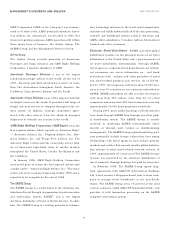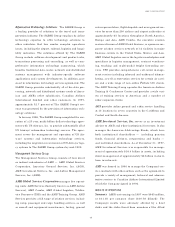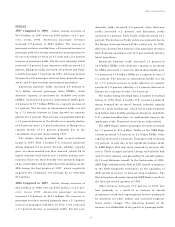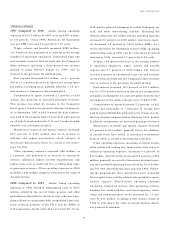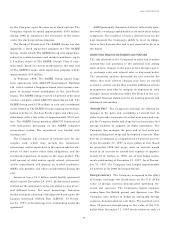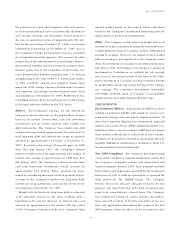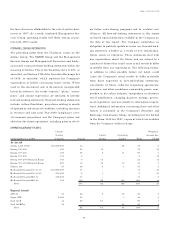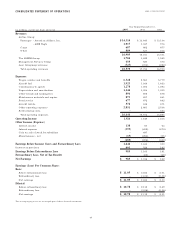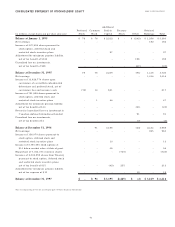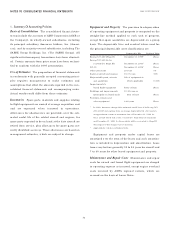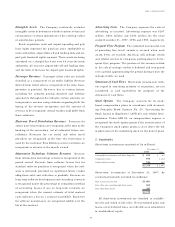American Airlines 1997 Annual Report Download - page 46
Download and view the complete annual report
Please find page 46 of the 1997 American Airlines annual report below. You can navigate through the pages in the report by either clicking on the pages listed below, or by using the keyword search tool below to find specific information within the annual report.
AMR CORPORATION
44
the systems of other parties (e.g., Federal Aviation Admin-
istration, Department of Transportation, airport authori-
ties, data providers) upon which the Company’s busi-
nesses also rely will be converted on a timely basis. The
Company’s business, financial condition, or results of
operations could be materially adversely affected by the
failure of its systems and applications, those licensed to or
operated for third parties, or those operated by other par-
ties to properly operate or manage dates beyond 1999.
The Company expects to incur significant internal staff
costs, as well as consulting and other expenses, related to
infrastructure and facilities enhancements necessary to
prepare its systems for the Year 2000. The Company’s
total estimated cost of the Year 2000 compliance program
is approximately $215 million to $250 million, of which
approximately $65 million was incurred as of Decem-
ber 31, 1997. The remaining expenses are expected to be
incurred primarily in 1998. A significant portion of these
costs are not likely to be incremental costs to the Compa-
ny, but rather will represent the redeployment of existing
information technology resources. Maintenance or modi-
fication costs associated with making existing computer
systems Year 2000 compliant will be expensed as
incurred.
The costs of the project and the date on which the
Company plans to complete the Year 2000 compliance
program are based on management’s best estimates,
which were derived utilizing numerous assumptions of
future events including the continued availability of cer-
tain resources, third party modification plans and other
factors. However, there can be no guarantee that these
estimates will be achieved, and actual results could differ
materially from these estimates. Specific factors that
might cause such material differences include, but are not
limited to, the availability and cost of personnel trained in
this area, the ability to locate and correct all relevant
computer codes and similar uncertainties.
Airline Transportation Taxes The Federal airline pas-
senger excise tax, which was reimposed in the first quar-
ter of 1997, expired on September 30, 1997. A replace-
ment tax mechanism took effect on October 1, 1997.
Over a five year period on a sliding scale, the airline tick-
et tax will be reduced from 10 percent to 7.5 percent and
a $3 per passenger segment fee will be phased in.
Additionally, the fee for international arrivals and depar-
tures was increased from $6 per departure to $12 for each
arrival and departure and a 7.5 percent tax was added on
the purchase of frequent flyer miles.
Dallas Love Field In 1968, as part of an agreement
between the cities of Fort Worth and Dallas to build and
operate Dallas/Fort Worth Airport (DFW), a bond ordi-
nance was enacted by both cities (the Bond Ordinance).
The Bond Ordinance required both cities to direct all
scheduled interstate passenger operations to DFW and
was an integral part of the bonds issued for the construc-
tion and operation of DFW. In 1979, as part of a settle-
ment to resolve litigation with Southwest Airlines, the
cities agreed to expand the scope of operations allowed
under the Bond Ordinance at Dallas’ Love Field. This set-
tlement was codified by Congress and became known as
the Wright Amendment. The Wright Amendment limited
interstate operations at Love Field to the four states con-
tiguous to Texas (New Mexico, Oklahoma, Arkansas and
Louisiana) and prohibited through ticketing to any desti-
nation outside that perimeter. In 1997, without the con-
sent of either city, Congress amended the Wright Amend-
ment by (i) adding three states (Kansas, Mississippi and
Alabama) to the perimeter and (ii) removing all federal
restrictions on large aircraft configured with 56 seats or
less (the 1997 Amendment). In October 1997, the City of
Fort Worth filed suit in state district court against the City
of Dallas and others seeking to enforce the Bond Ordi-
nance. Fort Worth contends that the 1997 Amendment
does not preclude the City of Dallas from exercising its
proprietary rights to restrict traffic at Love Field in a man-
ner consistent with the Bond Ordinance and, moreover,
that it has an obligation to do so. American has joined in
this litigation. Thereafter, Dallas filed a declaratory judg-
ment action in federal district court seeking to have the
court declare that, as a matter of law, the 1997 Amend-
ment precludes Dallas from exercising any restrictions on
operations at Love Field. As a result of the foregoing, the
future of flight operations at Love Field and American’s
DFW hub is uncertain. To the extent that operations at
Love Field to new destinations increase, American may be
compelled for competitive reasons to divert resources
from DFW to Love Field. This diversion could adversely
impact American’s business.


